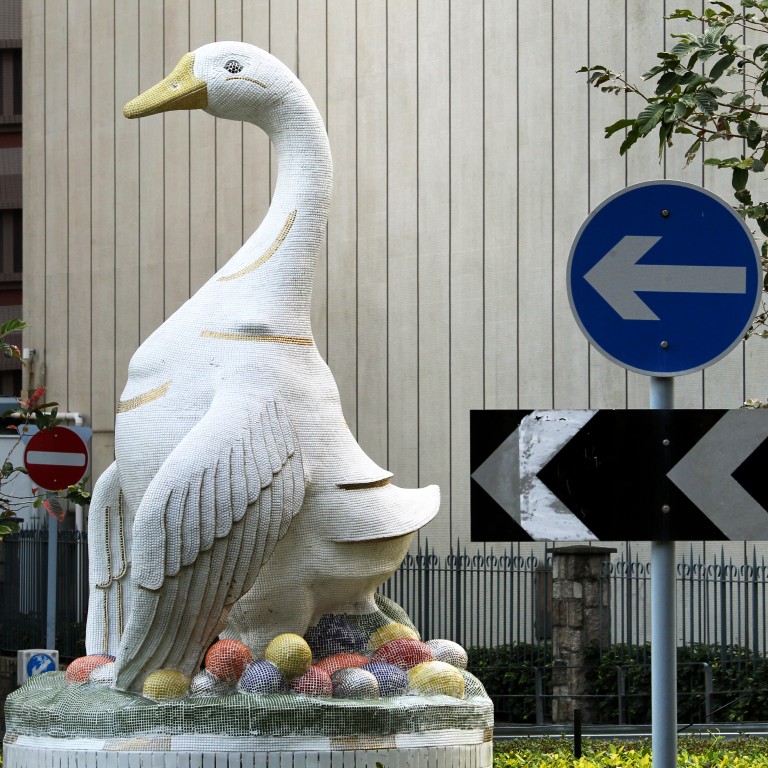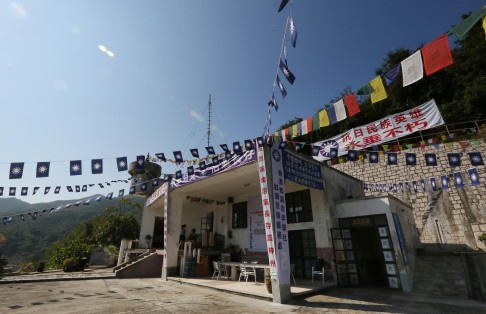
Can Hong Kong district councils spend HK$1.8b wisely, author asks
Research examines each council's plans for spending their HK$100 million funding for community projects and finds both good and bad. The book could be a useful guide for voters in November's council elections
Cheers erupted when Chief Executive Leung Chun-ying announced in 2013 that HK$1.8 billion would be allocated for community projects across the city - HK$100 million for each of the 18 districts. District councillors wasted no time coming up with schemes to improve their neighbourhoods.
However, disputes have since broken out over a lack of public consultation and conflicts of interest in some projects. Among the most controversial was a proposal to spend HK$50 million on installing a "world-class" musical fountain along the Kwun Tong promenade; detractors condemned it as an extravagant and wasteful use of funds.

Then the district council of Kowloon City came under fire when it voted to use its entire allocation on rejuvenating the Cattle Depot Artist Village; critics were angered not only because there was no consultation, but also by the haste - councillors approved the plan after just one hour's discussion.
All 18 district councils have finalised their proposals, which now await Legislative Council approval. Even so, there is still public opposition to some plans.

Determined to find out whether the HK$1.8 billion of public money would be put to good use, broadcaster Paul Lam Chi-kit brought together a team of researchers, pored over piles of council documents and interviewed more than 50 district councillors to get to the bottom of councils' decision-making over the past two years. The results have been collated in a book, unveiled at the recent Hong Kong Book Fair.
Lam, who trained in television and radio broadcasting in the US, says he became interested in neighbourhood issues while hosting programmes at Commercial Radio. It began when he undertook a series of reports on Times Square mall. At the time, the mall was trying to prevent people from sitting around its plaza, so Lam went to Causeway Bay and interviewed passers-by about their response to being driven away by security personnel. It made people aware that the plaza is a public space and pedestrians were subsequently allowed to rest their feet there. "That was when my interest in community affairs was piqued," Lam says.
He left in 2013 after six years with the radio station to join Sow Ideas, a social enterprise focused on "solution journalism" that produces reports that look at ways of resolving social issues. As executive producer, Lam initiated a project investigating the use of the HK$1.8 billion government allocation. A video team visited each district, interviewed the councillors behind various proposals and recorded residents' responses to the ideas. They turned the clips into reports for online viewing and an 18-segment audio version was also broadcast on Commercial Radio earlier this year.

The idea, Lam says, is to give a complete picture of all the projects being proposed, rather than simply highlight those that went awry, such as the plan for a Sham Shui Po arts centre that became mired in accusations of conflicts of interest.
"No one reports on the good proposals. It's easy to keep criticising government plans to vent frustration. But what the news media and public overlook are solutions to problems."
He wants to inform the public about how the proposals may affect their communities.
Lam's team found basic information from the district councils' websites, but he also listened to live broadcasts of council meetings. And there was plenty of legwork, with visits to areas such as Sha Tau Kok (which required securing a permit), where a councillor showed him where a proposed hiking trail would be laid out.
Among the schemes Lam applauds is the Kwai Tsing District Council's proposal to establish two mobile dental clinics and five eye health centres.
"The plan is among the few council proposals that benefit residents across the district," he says. "Vanity projects like the construction of the music fountain in Kwun Tong do not have clear beneficiaries."

Another praiseworthy scheme is the Southern District Council's plan to introduce dining facilities at the Aberdeen wholesale seafood market, he says.
"Many people don't know that 70 per cent of our seafood comes in via Aberdeen. The council wants to construct kitchen and dining facilities [costing HK$80 million] in the market so that people can eat the freshly caught seafood on the spot."
District councils have long been ridiculed for coming up with poorly thought out schemes and focusing their energies on trifling matters such as collection points for dog faeces.
For instance, the Tsuen Wan district council attracted widespread derision in 2013 when it spent HK$1.2 million to put up a giant statue of a goose in Sham Tseng as recognition of the roast fowl that the village is known for. Recently, councillors in Eastern district had two rain shelters constructed in Quarry Bay, but were met with a barrage of objections as the structures took up half the pavement and obstructed pedestrians.
No one reports on the good proposals. It's easy to keep criticising government plans to vent frustration. But what the news media and public overlook are solutions to problems
Political commentator Kengo Ip, who has read reckons what Lam has done is admirable.
"No one used to pay attention to what district councils did. His book can raise issues like the demarcation of the district. For instance, Kwai Ching is made up of Kwai Chung, a grass-roots area, and Tsing Yi, which is mostly middle class. How can funding reconcile the different needs? Readers can use the information to assess the quality of their district councillors."
For all the ridicule district of councils, Lam says they are powerful institutions, noting how top ministers had to work hard to persuade councillors to support controversial proposals such as the expansion of the landfill in Tuen Mun. Lam hopes the book can be a guide for voters during the district council elections in November.
With the abolition of appointed councillors, all 431 councillors serving the 18 districts will be directly elected for the first time. This will make the district council "the most democratic institution in the city" and residents should exercise their right to vote, Lam says.
In previous district polls, he notes, the turnout was quite low among young voters, who focused criticism on how establishment political parties try to sway votes by offering free tours and banquets. (Although young people made up 16.8 per cent of the electoral roll in the 2011 district council elections, they accounted for just 12.3 per cent of votes cast.)
Everyone, Lam says, should take a greater interest in what is happening in their communities, and make their views known during public consultations on various district council schemes. But most people raise objections only after the plans are finalised.

"If people are not happy with their existing district councillors, they should come out during the election and vote them out," Lam says. "A district council seat involves just over 2,000 votes, so one person's vote carries a lot of power."
District councils have access to a lot of useful data, which can be found on their websites, Lam adds. For example, they know about daily habits such as when bus stations are most crowded because such information is needed when considering the reorganisation of bus routes.
"However, councils aren't making good use of the data they have now. They should use it to work with social enterprises to improve the lives of residents," says Lam, whose scrutiny of projects didn't end with the book's publication.
"After the projects are completed and the structures built, I will go to the districts again to record the results and how locals receive them."
The good, the bad and the unlikely
We asked Paul Lam of social enterprise Sow Ideas to identify some projects that he believes deserve the cash district councils are planning to use, and others that are proving more contentious.
MOST PRACTICAL
Kwai Tsing
Two mobile dental clinics and five eye health centres (proposed by a group of councillors)
Due to a high concentration of poor and elderly residents in Kwai Chung, the council discarded other ideas such as hillside escalators and a transport interchange in favour of more health facilities.
Southern district
Dining facilities at the Aberdeen wholesale seafood market (proposed by a group of councillors)
"The plan dovetails with the future opening of the MTR station and [an anticipated] boom in tourism," Lam says.
Tsuen Wan
Create an elevated park by connecting a network of walkways surrounding the MTR station and convert the site of the little-used Sai Lau Kok park into an indoor activity centre (proposed by Man Yu-ming, New Territories Association of Societies)
The latter was among nine ideas mooted in a community enhancement report comissioned from the University of Hong Kong.

MOST CONTROVERSIAL
Kwun Tong
Music fountain on the promenade (proposed by Poon Chun-yuen, DAB)
The plan has undergone several revisions from the original idea to construct a fountain in the sea off Kwun Tong. Concerns about high maintenance costs led to suggestions of a platform that could be moved and stored on land when not in use, but that too was eventually shelved due to concerns over damage to marine life. Councillors eventually opted for a site on the promenade across from the Kai Tak cruise terminal.
Sai Kung
Converting a Buddhist monastery in Tiu Keng Leng into a heritage centre (proposed by Lam Wing-yin, Democratic Party, and Sing Hon-keung, independent)
The monastery was relocated from Rennie's Mill squatter camp when the settlement was demolished in 1996 to make way for a new town development. Last month the government served the abbot an eviction notice. He was so upset he set fire to his arm in protest.
Sham Shui Po
Arts centre featuring rehearsal spaces and shops at Shek Kip Mei (proposed by Shum Siu-hung, Business and Professionals Alliance for Hong Kong)
Pitched as a way to nurture audiences for the West Kowloon Cultural District, the plan was rejected after news emerged that five councillors were on the board of the company tasked with building the new complex.
Sha Tin
Soccer pitch built over a nullah (proposed by a group of councillors)
The design did not include space for changing rooms because of fears that the platform might not support the weight of such a facility. The nearest place where players would be able to change is a nearby public toilet.

